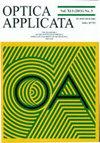Selected visual parameters related to the working conditions of musicians
IF 0.5
4区 物理与天体物理
Q4 OPTICS
引用次数: 0
Abstract
Professional musicians are required to practice playing instruments for long hours, which often exerts significant impact on their health. Attention should be given to the specificity of playing each instrument, including uncomfortable and sustained body position and repetitive movements causing long-term strain of certain parts of the body. The aim of this study was to evaluate the impact of long-term playing wind and string instruments on the visual system. Ninety male and female subjects aged 15 to 30 years were included in the study and divided into two groups: musicians (Msc) and non-musicians (nMsc). Significantly less subjects in the Msc group had properly corrected vision, wore optical prescription recommended by an ophthalmologist/optometrist, and/or underwent any eye examination at all in their lifetime, even though more subjects in this group experienced certain asthenopic symptoms. Also, accommodative amplitude got statistically worse under dim illumination conditions, accommodative facility was significantly different between musicians and non-musicians, although there were no differences between the groups when tested in bright illumination. None of the music stands used by the study subjects met the respective standards concerning uniform illumination rates. Playing string and wind instruments is a challenge for the visual system due to the forced body and head positions, and asymmetry between the visual plane and the plane of regard as well as non-uniform illumination in the working environment. However, conditions such as correct working distance and proper tilt of the music stand may be beneficial to the visual system. It is the role of optometrists to properly educate their patients about the importance of appropriate vision correction, especially in dim light and under adverse working conditions and to communicate the impact of such conditions on the visual system.选择与音乐家工作条件相关的视觉参数
专业音乐家需要长时间练习演奏乐器,这往往对他们的健康产生重大影响。应注意演奏每种乐器的特殊性,包括不舒服和持续的身体姿势以及导致身体某些部位长期劳损的重复动作。本研究的目的是评估长期演奏管弦乐乐器对视觉系统的影响。90名年龄在15至30岁之间的男女受试者被纳入研究,并被分为两组:音乐家(Msc)和非音乐家(nMsc)。在Msc组中,很少有受试者在他们的一生中矫正了视力,佩戴了眼科医生/验光师推荐的光学处方,和/或接受过任何眼科检查,尽管该组中更多的受试者经历了某些弱视症状。此外,在昏暗的照明条件下,调节幅度在统计学上更差,音乐家和非音乐家之间的调节设施有显著差异,尽管在明亮的照明条件下,两组之间没有差异。研究对象使用的音乐架都不符合各自的均匀照度标准。演奏弦乐器和管乐器对视觉系统来说是一个挑战,因为身体和头部的位置是被迫的,视觉平面和观察平面之间的不对称以及工作环境中不均匀的照明。然而,适当的工作距离和音乐支架的适当倾斜等条件可能对视觉系统有益。验光师的职责是正确地教育患者适当的视力矫正的重要性,特别是在昏暗的光线和不利的工作条件下,并告知这些条件对视觉系统的影响。
本文章由计算机程序翻译,如有差异,请以英文原文为准。
求助全文
约1分钟内获得全文
求助全文
来源期刊

Optica Applicata
物理-光学
CiteScore
1.00
自引率
16.70%
发文量
21
审稿时长
4 months
期刊介绍:
Acoustooptics, atmospheric and ocean optics, atomic and molecular optics, coherence and statistical optics, biooptics, colorimetry, diffraction and gratings, ellipsometry and polarimetry, fiber optics and optical communication, Fourier optics, holography, integrated optics, lasers and their applications, light detectors, light and electron beams, light sources, liquid crystals, medical optics, metamaterials, microoptics, nonlinear optics, optical and electron microscopy, optical computing, optical design and fabrication, optical imaging, optical instrumentation, optical materials, optical measurements, optical modulation, optical properties of solids and thin films, optical sensing, optical systems and their elements, optical trapping, optometry, photoelasticity, photonic crystals, photonic crystal fibers, photonic devices, physical optics, quantum optics, slow and fast light, spectroscopy, storage and processing of optical information, ultrafast optics.
 求助内容:
求助内容: 应助结果提醒方式:
应助结果提醒方式:


